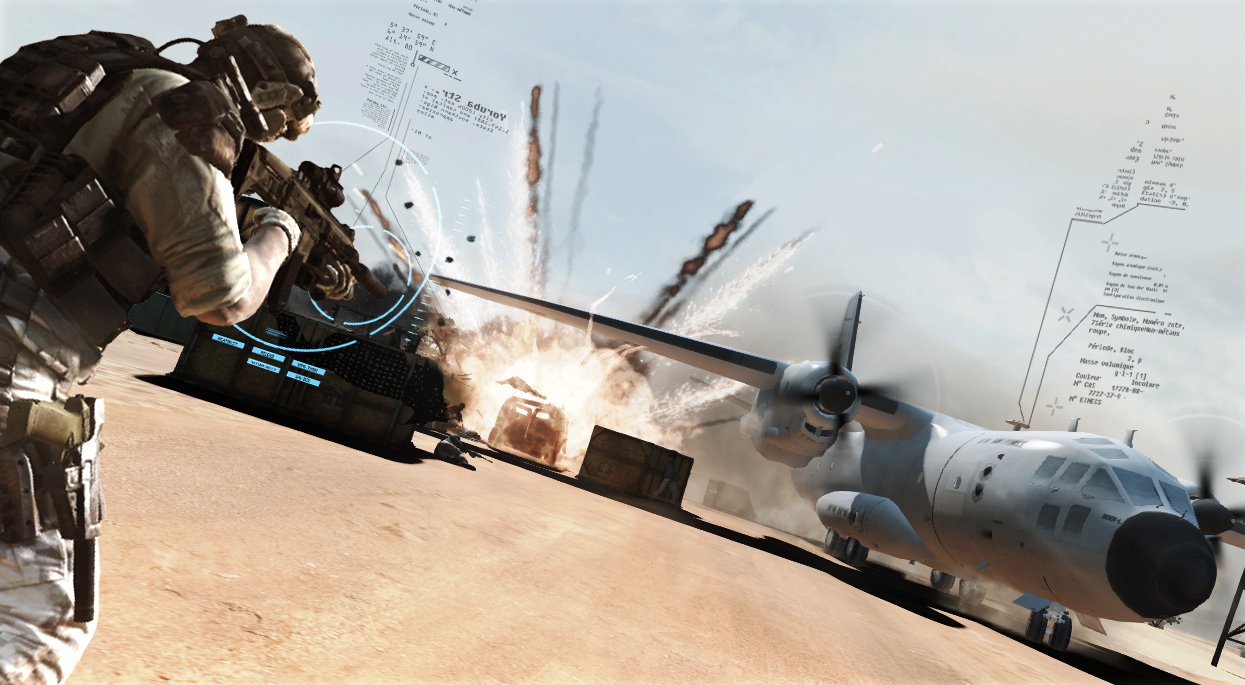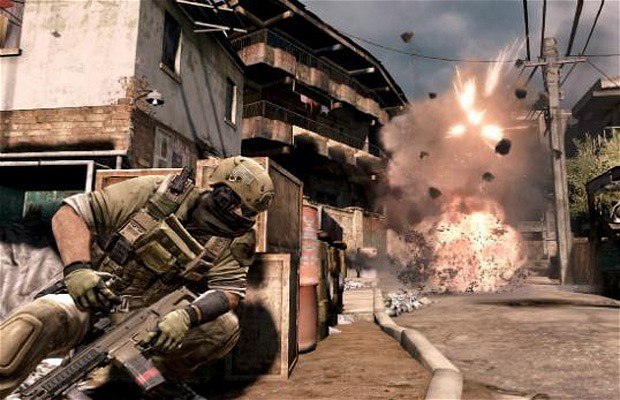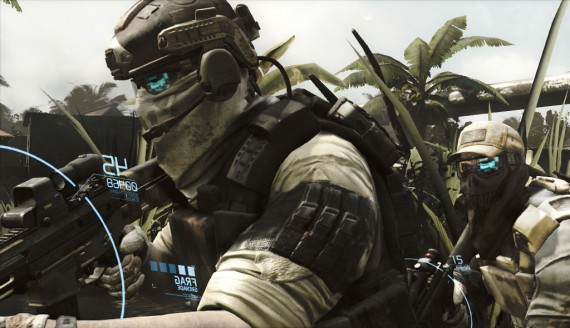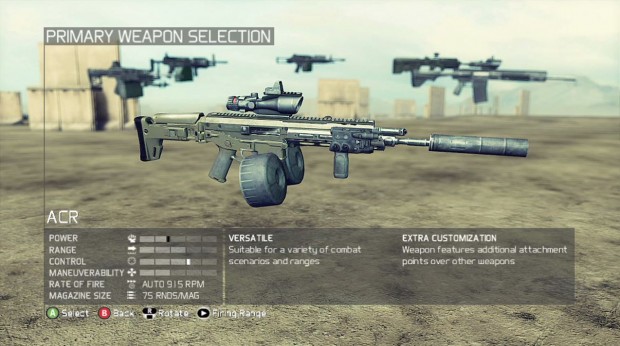It has been five years since the last proper Ghost Recon title, and now, Ghost Recon: Future Soldier is stepping up to the plate. It’s a game rich with military intricacies that standout in a world chalk full of military shooters, but minor structural quirks restrain it from developing into something outstanding and exceptional.
Tom Clancy is known for his conspiracy empowered fiction, but in the video game world, he’s known for slapping his name on a plethora of military titles. I’m sure his involvement in Ghost Recon: Future Soldier was slim to none, as its story is nothing to shake a stick at. As the player, you take control of Kosak, a member of a covert operative quartet code named Ghosts. Your squad is given the task of hunting down a mysterious arms dealer who’s responsible for the death of another military squad of Ghosts. The story is a universal, villain to villain, bread crumb trail. Your team’s initial investigation unveils a new villain, and that villain’s destruction leads to yet another villain, and so forth, and so forth. This lack of antagonistic permanence convolutes the story and never leaves the player with a satisfying conflict; it does however, give you various reasons to span the globe on numerous operations.
The fictional blanks are filled in via cutscenes and mission briefings. The mission briefings are uninspired, and resemble Call of Duties’ greatly; the camera zips and zooms around a global map as a narrator explains the mission, all the while supplying you with pictures of the next target, or other characters. On the other hand, the cutscenes attempt to develop and humanize the cast, but it is hindered by stiff facial animations and questionable voice acting. Many disposable characters or extras fall into the dude/bro category of dialogue, which is horrendous for obvious reasons.

Overall, the story is forgettable and serves only one purpose: to take you around the world and point your gun at an array of enemies. Fortunately for the game, pointing your gun at things is a very fulfilling experience, and the scenery is alluring. Future Soldier is graphically competent, with stunning environments and a futuristic sheen that’s very stylistically pleasing. Although, some of the NPCs (especially the civilians) look a bit shoddy, and some objects lack proper detail in their textures. That being said, these graphical downfalls don’t cripple the overall aesthetic.
The game also excels in categories most modern shooters don’t, while falling into a few soporific traditions. Tom Clancy games have always been stealth centric and Ghost Recon is no exception. Its gameplay entails heavy contemplation over force, and these strategically stealthy aspects reward you with the feeling of self-achieved badassery. These stealth mechanics put great emphasis on combat awareness; you must know where your enemies are before executing your strategic maneuvers. It’s a sort of spot and drop flow that vastly augments the overall combat experience.
Throughout the game, I was continuously thankful for the in-game HUD. It greatly helps you identify and keep track of your enemies. It does a great job of stylistically representing imperative information on the fly. For example: spotted enemies will show up through objects as yellow silhouettes, objective indicators will hover in the sky, and team movements are all clearly displayed. It all looks great and clear.

The essential component that ties it all together are "sync-shots". You can virtually tag your enemies so they display a number from 1 to 4 on your HUD. Once the desired number of enemies are tagged, you wait for your allies to line up their shots on the oblivious targets. Then, on your cue (either on your shot or by holding R2), they fire, dropping the enemies concurrently. Your squad mates are also very reliable, keeping out of sight and moving into position with ease. Observing your enemies patterns to implement these sync-shots, without setting off any alarms, is a satisfying achievement, and it’s at the core of most missions.
The game also provides the player with a diverse toolset of militaristic toys. The tools provide cover, help spot enemies, traverse areas unattainable by infantry units, and help destroy your foes. All this gear adds freedom and diversity to the battlefield and is crucial to conquering your enemies efficiently.
While the game focuses heavily on stealth, it also has copious amounts of high octane battles. These battles rely on teamwork, and above all, cover. The game supplies you with varied armaments that cater to many styles of gunplay. It also has one of the more interesting suppressive fire mechanics that I’ve seen in a while. If an enemy is raining thunder on you while you’re behind cover, the camera will zoom in on your character as he crouches lower. You’ll now have a hard time hedgehogging up to return fire. You’re realistically pinned. This mechanic works great and adds to the immersion, but it also lends some interesting tactics to the multiplayer, which I’ll get to in a moment.

While the single player’s stealth mechanics and action elements are both great, the game is at its finest when it gives you the freedom of creativity, not twisting your arm towards one approach or the other. Unfortunately, most missions force mandatory stealth gameplay for the first half (which means that raising an alarm is game over), and the second half of most missions are a mandatory gun battle. This pattern is established early in the game, and it doesn’t let up. The pattern is obvious: stealth to the objective, all hell breaks loose, fight your way to the extraction point. It linearizes the gameplay. Not to mention, these forced action sequences take away the option of a clean, 100% silent mission, which is kind of what the Ghost team is all about.
I found the most exciting areas were large with various tactical options. If I were to get caught in these areas, I’d have to deal with the consequences myself, which would mean combating the onslaught of alarmed enemies. Whenever I succeeded in not alarming a soul and clearing these areas, I felt unparalleled satisfaction and a great sense of achievement. These strategically free engagements were some of the most satisfying encounters that I’ve had with any modern, militaristic shooter.
The multiplayer is a whole other beast in itself. It implements all the fundamental mechanics from single-player, while developing its own characteristics. The multiplayer has various game modes, both co-operative and competitive. The competitive modes include Conflict, Decoy, Saboteur, and Siege, while the co-operative mode encompasses the entire campaign, and also includes a horde mode titled Guerilla. This abundance of modes ensures great replay value that’s only enhanced further by the game’s robust gun customization. The gunsmith provides scads of unlockable gun components that allow an immense amount of customization. Players can customize everything from scopes, to the triggers and pins, all of which influence the gun’s stats. It has some major depth and provides incentive to continuously hop on the multiplayer components.
Just like the game’s single-player, the online is heavily reliant on team work and battlefield awareness. Your team must work together to identify your enemies locations using tagging and gadgets, all the while flanking, suppressing (with its exceptionally neat, aforementioned mechanic), and capturing and defending objectives. All modes are great, especially with a tightknit squad, and I’m looking forward the inevitable clans that will develop online.
Ghost Recon: Future Soldier is a game that differentiates from the common conceptions of modern shooters. It isn’t afraid to ask the player to think, sometimes very carefully, about their actions before they act. It’s paced around its tactical bravado, rather than the typical run and gun mechanics. It mingles gunplay and stealth into a gratifying experience, where satisfaction is found in your own competence and thus, your achievements. It’s just a shame that the game structures your gameplay the majority of the time, instead of giving you the strategic freedom that makes its more enjoyable moments shine. Still, Future Soldier’s strengths are not dulled by its weaknesses, and it’s a game that deserves to be played by shooter fans and strategists alike.